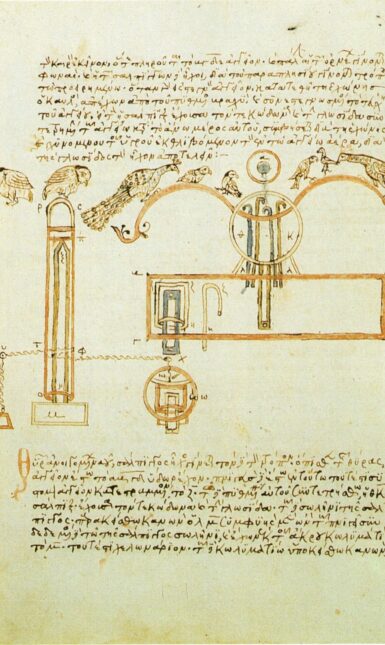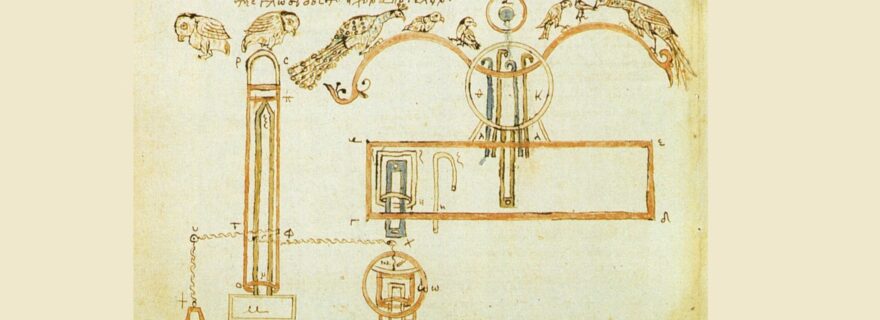Robots at a medieval court: The automata of tenth-century Baghdad and Constantinople
Moving and speaking statues – it sounds like something straight out of a science fiction novel, but they were central elements in the communication of power at the tenth-century Byzantine and Abbasid courts.
In June 917, a group of Byzantine ambassadors arrived at the court of the Abbasid caliph Al-Muqtadir (r. 908-932). Upon arrival, they were greeted with an elaborate ceremony, organized by the caliph’s vizier, Ibn al-Furat. The ambassadors were led through a series of no less than 24 palace rooms furnished with precious carpets, gilt armor and exotic animals, which took over two months to prepare. The trip ended up taking several hours, so that the Byzantines had to sit down multiple times, while servants brought in refreshments. Near the end of their tour, they entered a room where they saw something that blew their minds. The eleventh-century scholar Al-Khatib al-Baghdadi writes:
The amazement of the Ambassador grew even greater upon entering the Tree Room [Dar ash-Shajarah]; for there he gazed upon birds fashioned out of silver and whistling with every motion, while perched on a tree of silver weighing 500 dirhams. The Ambassador’s astonishment at seeing this was greater than at everything he had witnessed. (trans. Lassner 1970, 88)
Byzantine and Abbasid automata
The ambassadors’ astonishment may be a slight overstatement, as moving statues, or automata, had been present at Constantinople at least since the time of emperor Leo VI (r. 886-912) and possibly even before, under emperor Theophilus (r. 829-842). The most famous of these were probably the two lions guarding the throne of the emperor – the so-called ‘Throne of Solomon’ – in the Magnaura, the reception hall of the imperial palace. This throne is mentioned in the Antapodosis of Liudprand, bishop of Cremona, and the De Ceremoniis, a manual on state ceremonies attributed to emperor Constantine VII (r. 913-959). According to Liudprand, the throne contained an ingenious device that allowed it to be raised to the ceiling of the hall during an audience. Moreover, the lions flanking the throne started to roar at the arrival of foreign envoys, and again at specific moments during the carefully orchestrated reception ceremony. Both works also mention a gilded tree with singing birds in it, not unlike the one the Byzantine ambassadors saw in Baghdad some thirty years before.
Nor was Abbasid interest in mechanic devices unheard-of. During the late ninth century, works of the Hellenistic engineer Hero of Alexandria were translated from Greek into Arabic in Baghdad as part of a translation movement sponsored by the caliphs. One of these works was the Pneumatica, which contains a chapter on how to make mechanic birds sing with different voices (see Figure 1). Around the same time, three inventors known as the Banu Musa brothers used Hero’s work for their own inventions. One of them, Ahmad, compiled a book that was known as The Book of Ingenious Devices, containing about 100 inventions that make use of pneumatics and hydraulics to move automatically. An eleventh-century account by Al-Shabushti describes how caliph Al-Mutawakkil (r. 847-861) had a tower constructed, furnished with all kinds of precious goods, among which a golden tree with mechanical birds perched on its branches and a throne made like the throne of Solomon. He did not enjoy his riches for long, however, because shortly afterwards, he developed an illness that lasted for six months and ordered the tower to be razed and the furniture to be melted down.


The imagery of the golden tree
It is certainly no coincidence that we find references to a golden (or gilded) tree so often in the sources. Although it is not entirely clear where the image stems from, the (palm) tree has been associated with divine kingship since ancient Babylonian times. In the medieval Mediterranean we find several palm trees, either as free-standing sculptures, or as decoration on regal objects. One famous example is the so-called ‘coronation mantle’ of king Roger II of Sicily, made in 1133-1134 (see Figure 2). Sculptures of trees could also be given as diplomatic gifts to other rulers. In the early seventh century, the Sassanian king Khosrow II gave such a tree to the Byzantine emperor Maurice.

The addition of bird automata, however, is something we only see in Constantinople and Baghdad some three centuries later. This aspect did not arise purely out of a fascination for ancient Greek technology, but had implications for the conception of rulership as well. In particular, it echoes the supra-religious figure of king Solomon/Suleyman, who, in the narrative of 1 Kings, is associated with wisdom of all kinds. In the Islamic tradition, Suleyman is moreover seen as a prophet, who had been gifted the power over nature. The ninth-century Abbasid author Al-Ya’qubi, drawing upon the Qur’an and subsequent hadith literature, mentions in his world history (ta’rikh) that “God subjected to him [that is, Suleyman] jinn and men, winds and clouds, birds and beasts”. It is very well possible that the Abbasid display of automata was part of a larger tradition linking the caliph with the prophet Suleyman and thus endowing him with a divine legitimacy. Specifically the birds, aerial creatures that emitted sound through pneumatic devices, can be seen as an evocation of Suleyman’s mastery over both nature and the winds, and thus as a pars pro toto of Solomonic kingship.
In Constantinople, kingship was likewise associated with Solomon, as can be gathered from the designation of the imperial throne as the Throne of Solomon (or more precisely, the Solomonic [Solomonteios] throne). It would be tempting to see the mechanic device that lifted the throne up in the air mentioned by Liudprand as an evocation of the same Solomonic association with the air. However, to my knowledge, no such tradition existed in Byzantium. Still we can assume that the display of moving and speaking sculptures of animals in Byzantium should be seen in the same tradition of mastery over nature. Rather than just curiosa or displays of technical genius, the trees and their mechanic inhabitants hereby become central images in the communication of imperial and caliphal power and, especially in the Abbasid context, as a legitimization of that same power.
The role of ambassadors
Still, we may ask the question how two very similar objects ended up in different places around the same time. To answer this question, it will be illustrative to go back to the beginning of this blog, to the Byzantine embassy of 917. In an age before (mass) tourism, diplomatic journeys made up almost half of all the long-distance journeys transmitted to us in our source material. As members of the elite, and direct intermediaries between rulers, ambassadors were the prime source of contact between centers of power and culture. It is not coincidental, then, that we have multiple examples of cultural exchange facilitated by diplomatic contacts. The introduction of the originally Byzantine Saint Nicholas in Western Europe, for instance, is a direct result of the Byzantine princess Theophanu’s marriage to emperor Otto II. Likewise, after hearing reports of a recent mission to Baghdad from his ambassador John the Grammarian, the Byzantine emperor Theophilus had a new palace constructed at Bryas, on the Asian side of the Bosporus, completely in Abbasid style.
The appearance of the mechanical birds in tenth-century Constantinople and Baghdad was likely the result of a going back and forth between the two centers of power. Although the source material is murky at times, the narrative should look somewhat like this. Diplomatic contacts during the ninth century had led to a growing interest in ancient Greek science and resulted in a large caliph-sponsored translation movement of Greek scientific works into Arabic. As part of a larger association between the Abbasid caliphs and the prophet-king Suleyman/Solomon, mechanical birds were made and incorporated in official court rituals. Byzantine ambassadors then brought stories of the wonders of the caliphal palace back to Constantinople, where the emperor, Constantine VII, decided to incorporate this element in his larger program of reforming court ceremonies. Perhaps – but the sources are too scarce to be sure – he decided to outdo his Abbasid rivals by having a ‘fly’-mechanism installed in his throne to make it even more Solomonic. But even if the one narrative that we have of this throne should be dismissed as orientalistic fantasy, we can gather from this case study how diplomatic contacts were instrumental in the transfer of concepts of rulership, as well as technological innovation across linguistic, cultural and confessional boundaries.
Further reading
- Brett, G. “The Automata in the Byzantine "Throne of Solomon"”, Speculum 29:3 (1954), 477-487.
- Iafrate, A. The Wandering Throne of Solomon: Objects and Tales of Kingship in the Medieval Mediterranean. Leiden: Brill, 2016.
- Lassner, J. The Topography of Baghdad in the Early Middle Ages. Detroit: Wayne State University Press, 1970.
© Ivo Wolsing and Leiden Medievalists Blog, 2023. Unauthorised use and/or duplication of this material without express and written permission from this site’s author and/or owner is strictly prohibited. Excerpts and links may be used, provided that full and clear credit is given to Ivo Wolsing and Leiden Medievalists Blog with appropriate and specific direction to the original content.


